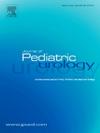Strain elastography for fertility assessment after pediatric testicular torsion: A long-term follow-up study
IF 1.9
3区 医学
Q2 PEDIATRICS
引用次数: 0
Abstract
Introduction
Testicular torsion (TT) is a urological emergency characterized by the twisting of the spermatic cord, leading to ischemia and potential testicular damage. If not treated promptly, TT can result in testicular atrophy and infertility. While early surgical intervention restores blood flow, the long-term impact on fertility remains a concern. This study investigates the role of strain elastography (SE) and testicular volume measurements in assessing testicular function after TT.
Objective
To evaluate the importance of strain elastography and testicular volume measurements in the long-term fertility assessment of adolescent patients who underwent surgery for TT.
Study design
This retrospective observational study included 15 patients operated on for TT between 2014 and 2020. Data on patient demographics, age at surgery, torsion laterality, symptom duration, degree of torsion, follow-up period, and semen analysis results were collected. SE and testicular volume measurements were performed during follow-up. Patients were classified as fertile or subfertile based on semen analysis. Statistical analyses were conducted using SPSS, including independent sample t-tests and Pearson correlation analysis.
Results
The volume of the torsed testis was significantly reduced compared to the contralateral testis (p = 0.0001). In the fertile group, there was a strong correlation between the affected and contralateral testis elastography values (r = 0.948), whereas this correlation was weak in the subfertile group (r = 0.158). The results suggest that in the fertile group, both testicles exhibited similar elastographic changes, while in the subfertile group, the affected testis showed independent variations.
Conclusion
This study highlights the importance of strain elastography and testicular volume measurements in the long-term assessment of fertility following TT. These techniques provide valuable insights into testicular function and potential fertility. Further research with larger cohorts and extended follow-up is needed to validate these findings.
应变弹性成像评估儿童睾丸扭转后生育能力:一项长期随访研究。
简介:睾丸扭转(TT)是一种泌尿外科急症,其特征是精索扭曲,导致缺血和潜在的睾丸损伤。如果不及时治疗,TT可导致睾丸萎缩和不育。虽然早期手术干预可以恢复血液流动,但对生育能力的长期影响仍然是一个问题。本研究探讨应变弹性图(SE)和睾丸体积测量在评估TT后睾丸功能中的作用。目的:探讨应变弹性成像和睾丸体积测量在青少年TT手术患者长期生育能力评估中的重要性。研究设计:本回顾性观察性研究纳入了2014年至2020年间接受TT手术的15例患者。收集患者人口统计资料、手术年龄、扭转偏侧、症状持续时间、扭转程度、随访时间和精液分析结果。随访期间进行SE和睾丸体积测量。根据精液分析将患者分为可育和欠育两组。采用SPSS进行统计分析,包括独立样本t检验和Pearson相关分析。结果:与对侧睾丸相比,扭转睾丸体积明显减小(p = 0.0001)。在可育组中,受影响的睾丸与对侧睾丸弹性成像值有很强的相关性(r = 0.948),而在非可育组中,这种相关性较弱(r = 0.158)。结果表明,在可育组中,两个睾丸表现出相似的弹性变化,而在非可育组中,受影响的睾丸表现出独立的变化。结论:本研究强调应变弹性图和睾丸体积测量在TT后生育能力的长期评估中的重要性。这些技术为睾丸功能和潜在生育能力提供了有价值的见解。进一步的研究需要更大的队列和延长的随访来验证这些发现。
本文章由计算机程序翻译,如有差异,请以英文原文为准。
求助全文
约1分钟内获得全文
求助全文
来源期刊

Journal of Pediatric Urology
PEDIATRICS-UROLOGY & NEPHROLOGY
CiteScore
3.70
自引率
15.00%
发文量
330
审稿时长
4-8 weeks
期刊介绍:
The Journal of Pediatric Urology publishes submitted research and clinical articles relating to Pediatric Urology which have been accepted after adequate peer review.
It publishes regular articles that have been submitted after invitation, that cover the curriculum of Pediatric Urology, and enable trainee surgeons to attain theoretical competence of the sub-specialty.
It publishes regular reviews of pediatric urological articles appearing in other journals.
It publishes invited review articles by recognised experts on modern or controversial aspects of the sub-specialty.
It enables any affiliated society to advertise society events or information in the journal without charge and will publish abstracts of papers to be read at society meetings.
 求助内容:
求助内容: 应助结果提醒方式:
应助结果提醒方式:


